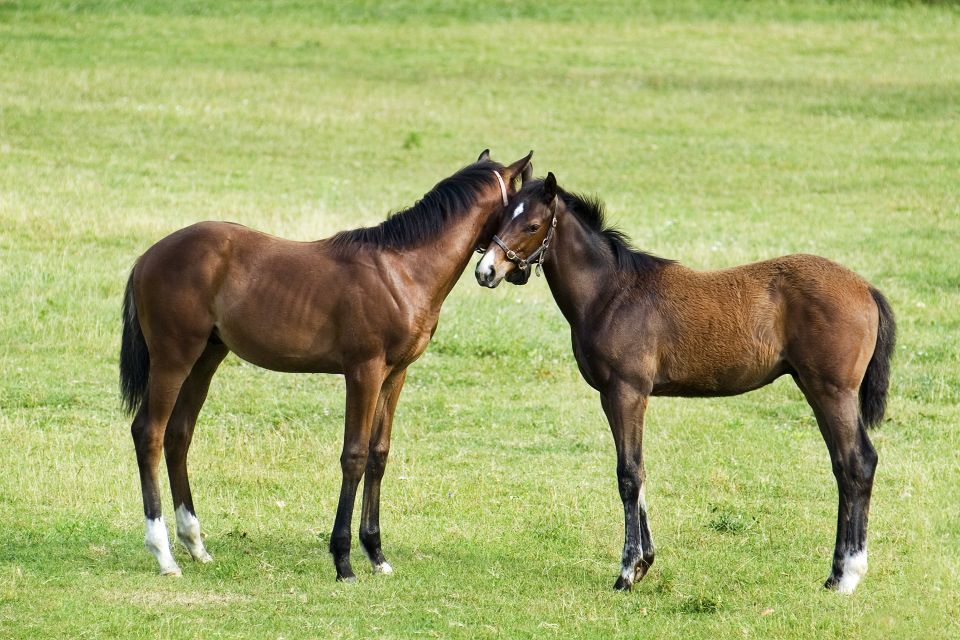28 March '24
The first time….
/
New Life/
Veterinary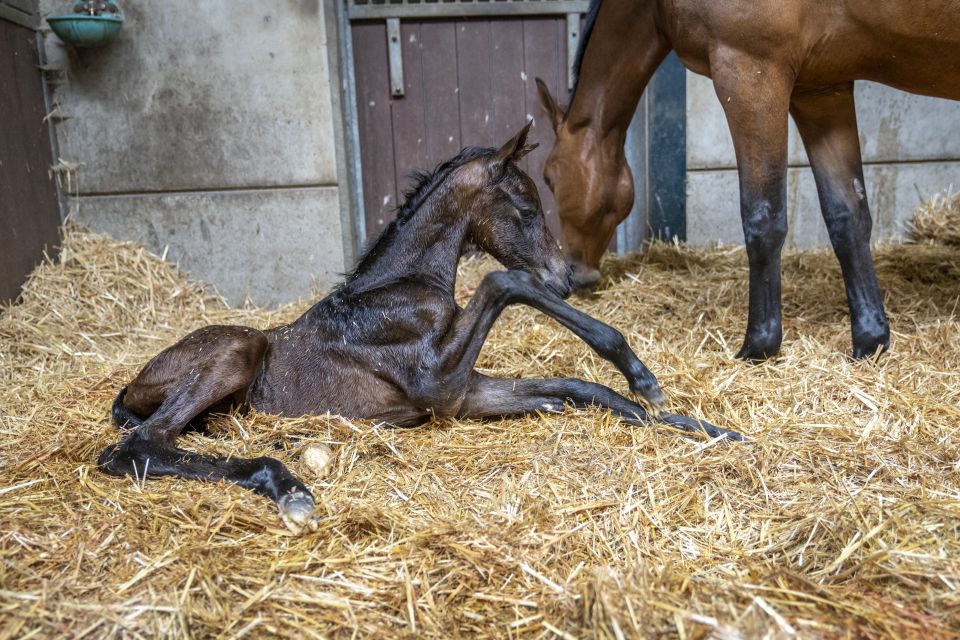
@ArndBronkhorst
The first time….
It may not be the first time, for you as a breeder, that a foal is born in your stables, but many breeders will confirm that this is time and again a special occasion. Not just the birth itself, but also the following days, weeks and months in which the foal gets new experiences every day. From the first time that it finds the dam’s nipple by itself, still on wobbly legs, to the moment that the time has come to wean it and to continue “on its own legs”. In this article a few of those” firsts” for the foal are described with some advice as to how you may help the foal cope wit hall this newness. ‘The first time….’
…taking a breath
Your foal has just been born. It is lying behind the mare in the straw, still wrapped in the membrane. The membrane is normally broken by the dam or by the foal itself, but in case this does not happen, it is important to lend a helping hand. Pull the membrane open and free the head of the newborn foal and clean out any slime from his nose, so that there is no impediment for it to take its first breath.
Advice: If the foal gives an apathetic impression, try to stimulate the foal by rubbing the ribs with a handful of straw.
…getting up
A healthy foal will try soon after its birth to get on its feet. This is essential in nature, because horses are flight animals and must be able to flee from possible enemies at any moment. For horses that are kept in domesticated conditions, this is, of course, not necessary. It is necessary, however, that the foal has suckled milk from the mare within a couple of hours since its birth and in order to do so, it will have to get on its feet first. So it is quite handy that the desire to get up is instinctive!
Advice: to encourage the foal to get on its feet, you can lightly pinch the middle of the backbone of the foal; this is the way the dam would do it with her mouth
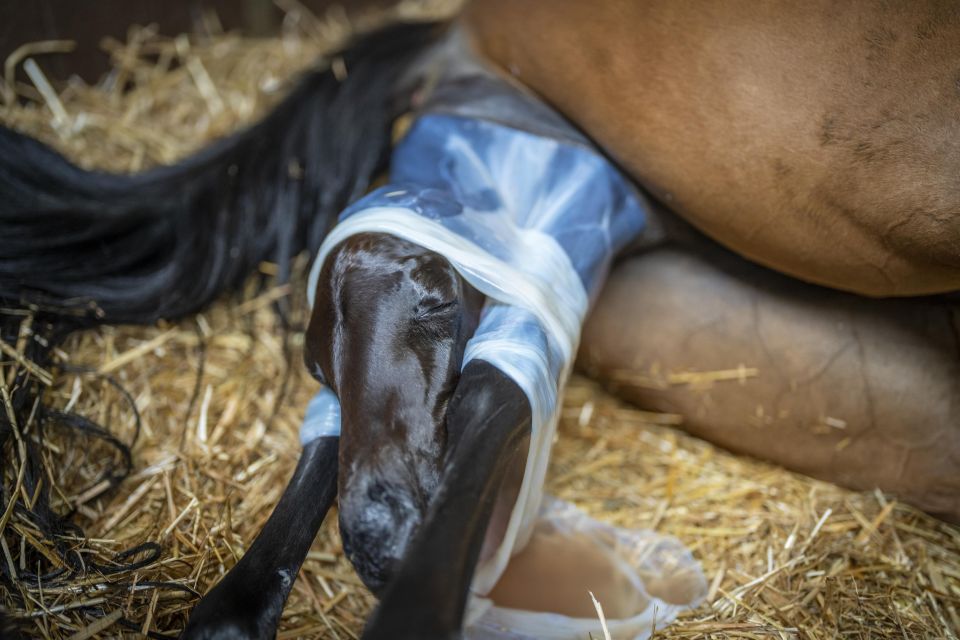
….suckling
The immunity status of a newborn foal is nil, because before birth it has not received any antibodies from its dam through the placenta (as is the case for humans). The foal receives its first immunity by suckling the colostrum (first milk from the dam). It is important that this happens as soon as possible after birth, since a foal without any immunity is very sensitive to infections. Colostrum has a different composition than the later milk from the dam because, in addition to the antibodies, it has a higher fat, protein, vitamin and mineral content to give the foal an optimum start in life. Mares often already leak a few drops of this milk before giving birth, which is visible on the inside of her hindlegs which will also be sticky. In most cases this is a sign that the birth will occur within 24 hours. If this does not happen and the mare is losing milk constantly, there is a danger that the foal has to forego (a certain amount of) the colostrum which is so important to it! In that case it is wise to milk the mare and freeze this milk, so that it can later still be given to the foal. In case of doubt of the quality of the colostrums, this can possibly be determined beforehand (the concentration of antibodies present can be measured) in order to be certain that the foal will develop a sufficient immune system by drinking it. It is also possible to have the immunity status of the foal checked after birth (the concentration of antibodies in the blood can be measured) to make sure that it has indeed received a sufficient dose. If the quality of the colostrum or the immune status of the foal is insufficient, it is worth to consider acquiring some colostrum from another mare (in addition).
The antibodies in the colostrum can be digested by the foal only in the first 24 hours after birth (maximum absorption is during the first 4 – 8 hours!), any later and absorption will decrease fast and to administer colostrums then is useless. If blood testing (f.i.. Snap Foal IgG test) shows that the immunity status of the foal after 12 – 18 hours is insufficient, you can still balance this by having blood plasma administered to the foal. However, blood plasma transfusions are fairly costly, so it is important to ascertain that the foal receives a sufficient amount of colostrum and therefore also antibodies! It is furthermore advisable to stable the mare, in the last months before she is due to foal, in the same stable as where she will stay with her newborn foal. The body of the mare is able to develop any antibodies required to cope with any germs present in that stable and so the foal will receive a tailor-made bunch of antibodies from the colostrum.
Advice: It sometimes happens that the dam does not allow the foal to suckle because her udder is very tight. Sometimes it is in that case sufficient to hold the dam while the foal is suckling. If need be, one can milk the udder to take off some of the pressure.
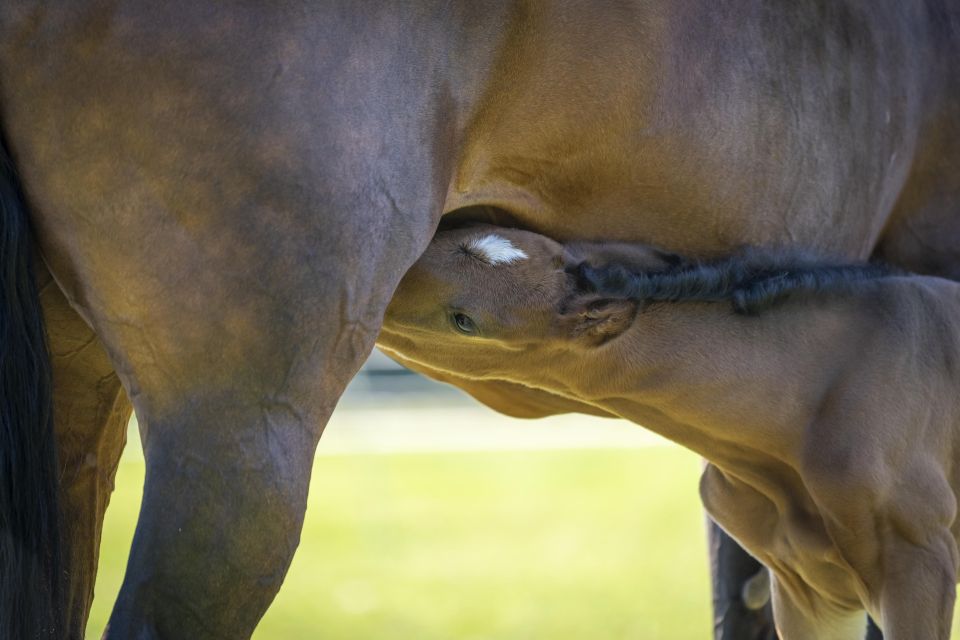
…. manure
The first manure of the foal is called meconium. About 2 hours after birth (at the latest by 24 hours after birth!) the foal will produce manure. The absorption of the colostrums stimulates the intestines of the foal to expel the meconium; in case of insufficient colostrum absorption one often finds that the foal is a little colicky. In this case one best call the vet, who will probably give the foal an enema and maybe also something against the colic cramps. This first manure is dark brown if not black, later the manure will be yellowish brown and the consistency becomes soft. After about 8 hours the foal will urinate for the first time. If it looks like the foal has difficulty urinating, you should call the vet at once.
Advice: One often sees young foals eating the manure of their dam, which is often frowned upon by breeders. But in this way the foal receives micro-organisms that are present in the intestines of the dam, which the newly born does not yet have but nevertheless needs for the later digestion of roughage (such as hay). Therefore the foal eating the manure of its dam can be considered a useful thing, it is necessary for the development of the micro-organisms in the appendix of the foal.
…… vaccination
The first injection the foal receives is often the standard foal injection, which is administered within 24 hours after its birth. Opinions about the desirability of the foal injection vary strongly. After a normal birth, when the foal suckles soon after it is born and so receives the colostrum (with antibodies!) it is not necessary to give it also the foal injection, since the colostrum has already started its immune system. It is assumed that this so-called maternal immunity lasts until the foal is 5 months. Vaccination until that time is not useful, it will not catch on well enough. The first ‘real’ vaccination should therefore take place at the age of 5 months and should be repeated after 4 to 6 weeks. A third vaccination should be given 6 months later (that is when the foal is about one year old), after that the three-step vaccination is complete and annual vaccination will suffice.
Note well: in the above, it was assumed that the mare had been properly vaccinated, for only then could her colostron offer the foal sufficient immunity. It is therefore important to ensure that the mare has been properly vaccinated, for that way the foal is vaccinated for free! A good vaccination programme for the mare in foal is to give her a last anti-flu/tetanus injection 3 months before the foal is expected and during her whole gestation at least three times against rhinopneumonia, namely in the 5th, 7th and 9th month. Vaccination against rhinopneumonia does not, unfortunately, offer full guarantee, but reduces the chances of her (and the foal) attracting the disease. Vaccinating all the horses in the stables (for horses not in foal, a twice yearly vaccination will suffice) will further reduce the risk, while it is furthermore to be recommended to avoid contact between the mare and horses from the outside as much as possible.
If the mare is not or not properly vaccinated, one should realise that the foal will thus be totally unprotected and runs a high risk. In that case, such a foal may best be vaccinated for the first time already at an age of 3 months, but many things can go wrong until then. And they can not be prevented with a single foal injection!
Advice: Another thing that is very important for the prevention of infections in the young foal is making sure that the navel is very thoroughly disinfected after separating it from the naval cord, to prevent noxious bacteria entering. One can disinfect the navel with a iodine or betadine solution. Let the naval cord snap off of its own accord; breaking or cutting it is not advisable.
Less deworming, more worm egg counts
For new-born foals it is important that the dam is properly dewormed during her pregnancy. This is the way to make sure that the worm larvae in the dam’s udder are killed so that the foal cannot become infected via the milk.
Still, in a natural environment every foal will be confronted with worms. Fortunately though, the foal develops a natural defence system against worms. But this is not a guarantee against diarrhoea caused by foal worms. It is however, not good practice to deworm foals during their first weeks. As long as the foal appears to be chirpy and drinks well, there is no need to worry about worms. But when the foal looks listless or isn't very interested in suckling from the dam then it’s better to be safe than sorry and consult a veterinarian.
Recommended practice is to give a foal its first dewormer after two to three months. At this time there is a risk of contamination by roundworm (ascarids). Symptoms are a shaggy coat and a fat belly. A roundworm infection can also lead to coughing, nasal discharge and colic.
Frequent deworming used to be common practice in the past, but recent scientific insights teach us that this practice increases the risk of worm resistance. The advice therefore is to examine the droppings first by carrying out a worm egg count (WEC) and subsequently customise the medication for deworming based on those findings.
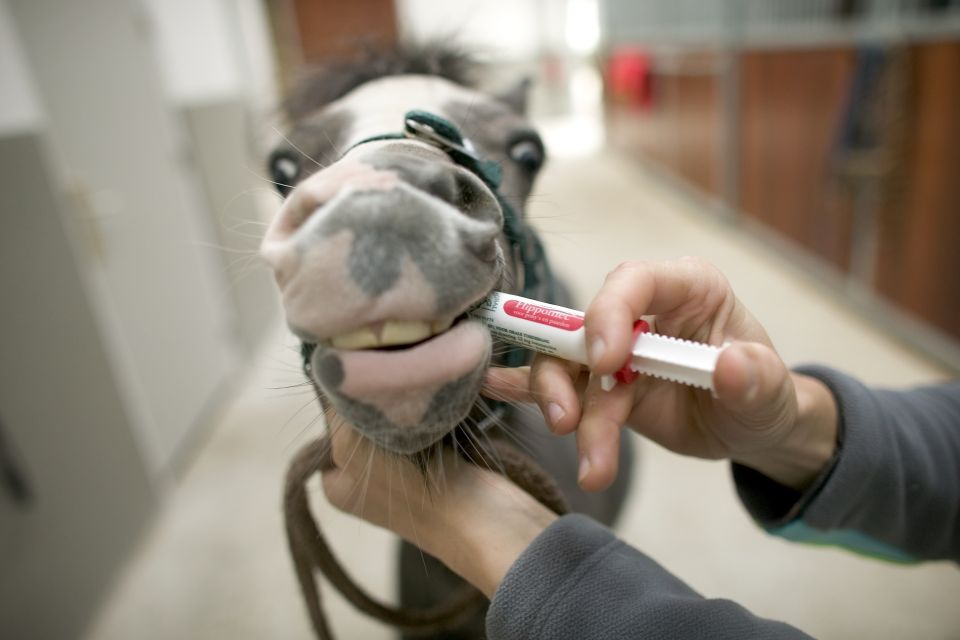
….haltering
Some breeders halter their foals for the first time already on the day after their birth, other breeders do it later, some even not until the weaning process starts. Between two extremes the middle way is often the best choice! A breeder who breeds a few foals a year as a hobby may have enough time to pay his foals sufficient attention, someone who has to make a living of breeding often does not manage to do this because of their large numbers and often they are not accommodated near the central stables. It is absolutely recommendable to get the horse closely acquainted with humans already in the first days after birth, since they and their action will then be considered ‘normal’. Everything the foal experiences early in life is imprinted in its memory. It is important that, already in this phase, the little horse is handles correctly and consistently. Because by the time that cuddly little thing will weigh 600 kilogrammes, the cute clawing with the foreleg or sweet nibbling has lost its charm!… In short: try to approach the foal in a constructive manner, but set clear limits for undesirable behaviour! Try to find the fine balance between docile and dominant … The degree in which a foal is easy to handle is not exclusively determined by the amount of attention paid to it by the owner. It also depends how the dam is raising it: a foal of an older, quiet dam will be more likely to trust humans than a foal of a young, shy mare that is constantly fussing with her foal and triest o keep it away from anything ‘new’.
Teaching a foal to be led on a halter is a delicate affair! The neck of a foal is very fragile. Never tie a foal up, because the chance is that it will start pulling so hard that it break its neck!
Advice: If the foal has to be kept temporarily immobile, for example for a vaccination or worming, one best keep it in a “chest-tail” grip. One hand is placed around the tail and the other around the chest, while pressing the foal against its dam or the wall.
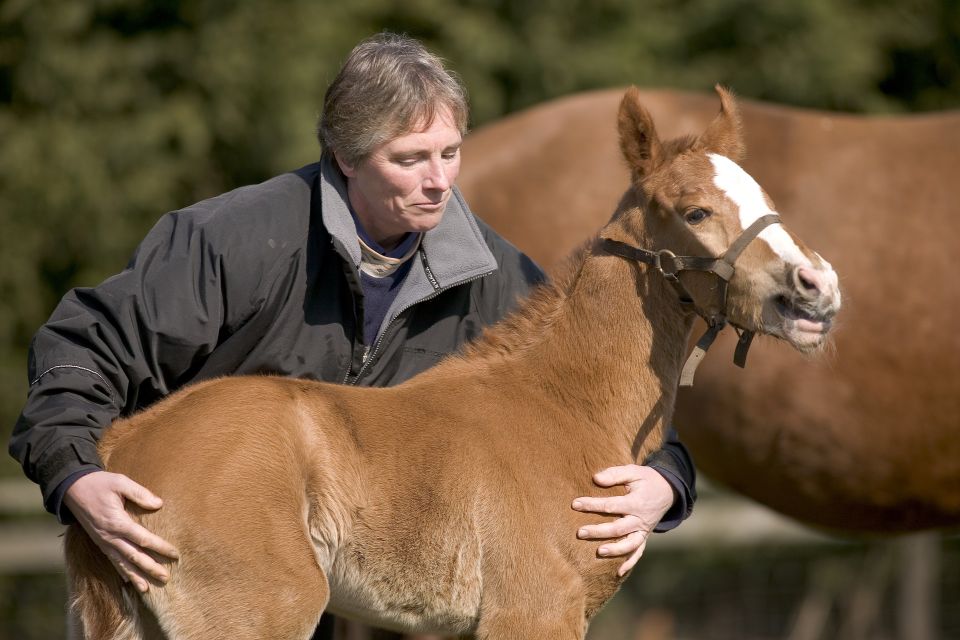
……transporting
With a newborn foal, the moment that it has to be transported may seem far away, but it may come sooner than expected. It may be that the breeder wants to have the mare fertilized again upon her first cycle, which is a week after birth, she and her foal will have to travel to the insemination station! One can transport a dam and foal by trailer or horsebox. In either case, the foal must be able to be beside its dam, for that is the most peaceful way to transport them. Move aside (and anchor) the partition in a 2 horse trailer, for example. In a horsebox it is important to block off any space in the partitions through which the foal can move away from the dam. Create a temporary barrier, from a few bales of woodshavings, for example, or board it up. During the loading it is important that the foal can follow the dam at foot into the trailer/horsebox. Never tie up the mare before the foal is beside her and the bar (or partition, in case of a horsebox) is closed! Young foals can be picked up or given a push behind their behinds, loading older foals may be more problematic. In that case, park the trailer or the horsebox in such a way that the foal cannot escape. Never tie up the foal; it is safer to have it standing free near its dam. When using a trailer, do not forget to close the top back flap (polyester or canvass). A foal may be a tiny thing, but it will not be the first time that the tiny thing manages to climb over barriers!
Advice: Make sure that the foal – which is never ties up – can not open the side door from the inside, which could lead to disastrous results! Close it properly on the outside or tie a rope around the outside with the handle blocked.
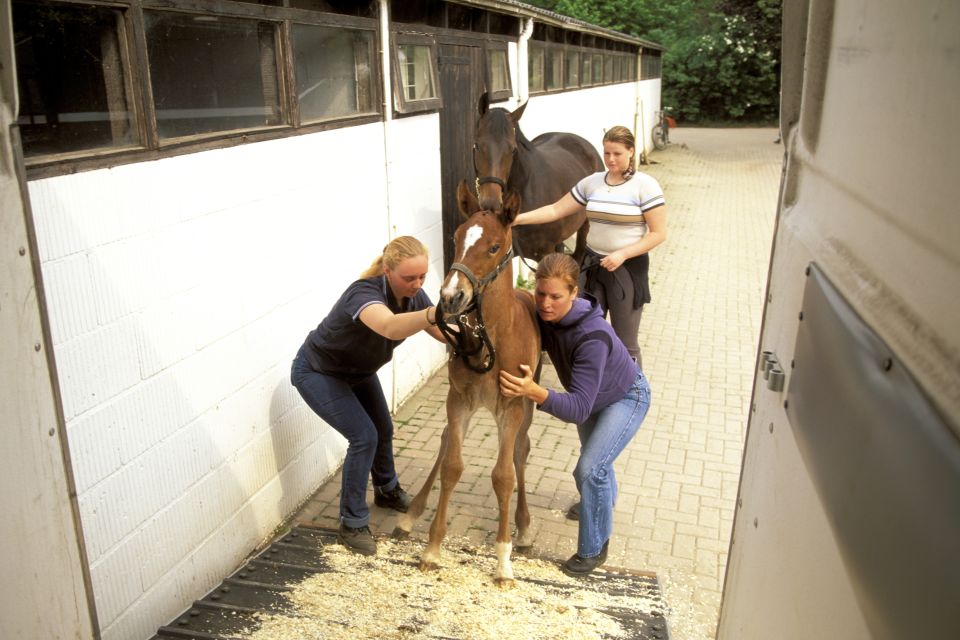
…. Going to a show (for example, the Z-Festival!)
Most studbooks nowadays organise foal championships, which are opportunities for the breeder to present his foal and have it assessed by a jury. Zangersheide, for example, has been organising the Z-Festival since 1999, for breeders who have registered their foal with Studbook Zangersheide. If you decide to have your foal participate in such an event, this will require a certain amount of preparation, for naturally you want to steal the show with your mare and foal! And for that, just plaiting them up the night before the show is not enough. Putting them in a stable at night a few weeks before the show and perhaps feeding them some nuts and vitamine will help to get the foal shed his “foal coat” better so that it can shine on the day of the show. Make sure that dam and foal have had all the required vaccinations in time; at shows that are visited by so many horses, there is always a high risk of infection. Besides the vet, ask the farrier to come along, so that he can make the hooves of dam look decent and ask him if he thinks it necessary to round off the foal’s hooves with the file. Do the latter more than one week before the show and not the day before as horses may walk sensitively on their feet when they have just been done. Of course, by that time, you have already made sure that the foal is well behaved and will follow its dam on a halter, because that is one thing you will not regret having spent time on. If you never transported the dam and foal together, it is wise to do a practice run or two beforehand, so you do not have any stress about that on the big day. After all, you are (also) doing it for fun!
Advice: If you have never started in a foal championship, perhaps you should first visit one to take a look at how things are done. What is important when presenting your dam and foal, do you have to wear special clothes when you lead your mare around, are you expected to just walk them in hand or do you also have to show them at the trot, etc. Good preparations will make an easy job!
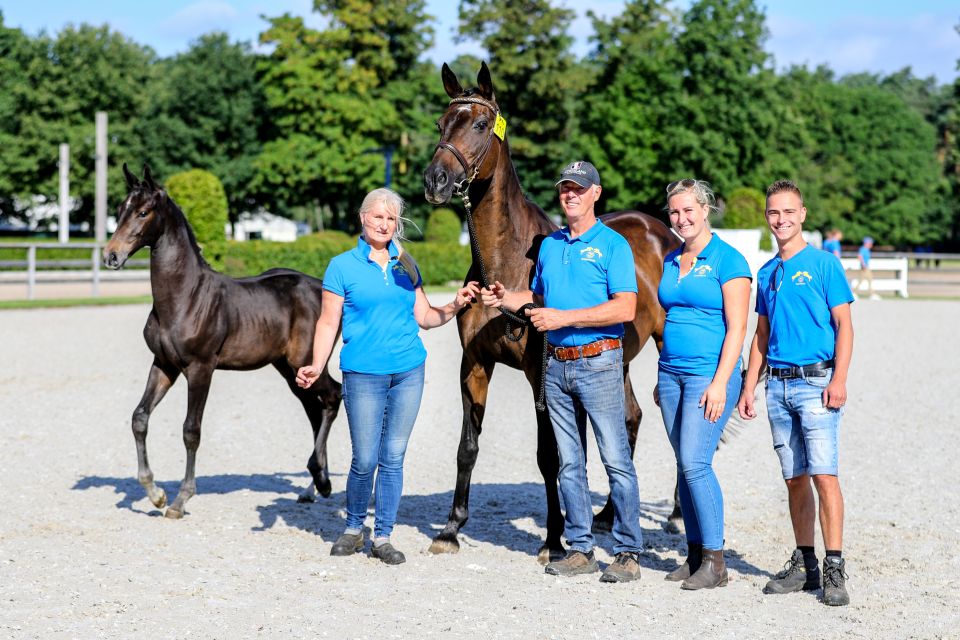
….weaning
No matter how cute they look together in the field, there will come a day when they have to go their separate ways. You may want to start using the mare again for the sport or you may want to breed with her again. In nature, the dam would also start distancing herself from the foal and refuse to suckle it. After all, if she is in foal again, she will have to invest in her new fruit and no longer have to spend energy in the production of milk for the old foal, which can by that time also provide for itself by grazing. The separation of dam and foal is called ‘weaning’. Weaning can be a gradual process, by separating the dam from the foal for increasingly longer period or abruptly, in one go. Here, too, opinions about what is best vary widely. Of course, it also depends on the circumstances; larger studfarms will be in favour of abrupt changes because they can join the newly weaned foals in a group. For a breeder with only 1 foal this is not possible and in that case the gradual method may be better. Whichever way, it is a stressful event for the foal. One can limit this stress by making sure that the foal has a mate, which it has preferably become acquainted already before. Another foal of roughly the same age is ideal, but in the absence of that any other (peaceful!) horse or pony can be a good alternative. At least, the foal will not feel so lonely. It is recommendable to keep the foal well away from its dam, so that they can not hear each other whinnying, which would only increase the withdrawal symptoms. Important point of attention when separating the foal from the dam is that the foal can not injure itself when it tries to escape (to get back to the dam). Keep the foal in a stable for the first few days, because in the field there is a good chance that it will run into the wiring or fencing. But also in the stable one has to avoid dangerous circumstances: there have been plenty of foal who got their legs stuck in the stable door or who try to climb out and they can easily harm themselves. Finally, one should realise that besides missing its dam, the foal will miss the suckling, which is a big change for a foal! To facilitate this change, it is wise to get the foal used to eating nuts and drinking water.
Advice: Do not change the type of nuts for the foal during weaning. If the foal is, for examples used toe at the nuts from its dam’s manger, keep on feeding those nuts for a while before changing to special foal feed. The weaning period is stressful enough by itself for a foal and if you also change its feed, the chances are that it will stop eating, which would seriously test its immune system.
